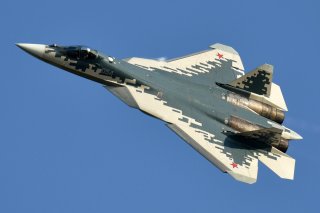Is Russia Developing a Sixth-Generation Stealth Fighter Jet?
Moscow is not alone in its announcement of the next generation of fighter aircraft. The United States, China, the United Kingdom, Italy, Sweden, Japan, Germany, Spain, Taiwan and France have all made progress on the jet fighter of the future.
Even as Russia continues to overcome production issues with its Su-57 stealth fighter, Moscow reportedly has its eyes set on a sixth-generation fighter jet, which could be developed under the MiG-Sukhoi joint brand. Such a fighter could build on the best features of the MiG-21, which has become the most-produced supersonic jet in aviation history; and the very capable MiG-35, as well as the Su-57.
“Possibly, this will be so: the fighter produced by the MiG-Sukhoi,” Rostec Aviation Cluster Industrial Director Anatoly Serdyukov told Tass on Tuesday. “But so far, all the work is at the stage of discussions and it is early to speak about details.”
This is not the first time that Russia has suggested a sixth-generation fighter jet could be developed in the near future. In March 2016, then-Deputy Prime Minister of Russia Dmitry Rogozin, announced that Russia had launched work on the sixth-generation combat plane. Rogozin said at the time that the Sukhoi Design Bureau had even submitted a preliminary project “for creating the sixth-generation fighter.”
While the delivery of the Su-57 has been slowed, in part due to problems in the advanced aircraft’s development, the fifth-generation fighter is still intended to succeed the MiG-29 and Su-27 in the Russian Air Force. It is unclear how the Su-57 would fare against the American Lockheed Martin-built F-35 Lightning II, which has become the world’s most dominant multi-role fighter. The F-35’s detection range, geolocation, threat identification, and system response capabilities allow the jet to precisely fix and destroy the most advanced threats in the world including every layer of Russia's latest SA-20 surface-to-air missile (SAM) system.
Instead of going on all-in with the Su-57, Moscow could now be turning its attention to a sixth-generation fighter, which specialists have noted would have the capability to perform combat missions without human participation and use its artificial intelligence along with the availability of a radio-photonic radar to reach a target. Such a fighter aircraft would also likely have the ability to utilize hypersonic speed and fly into the near-Earth space and employ weapons based on new physical principles.
Russian Aerospace Force Ex-Commander-in-Chief, Chairman of the Federation Council’s Defense and Security Committee Viktor Bondarev previously told TASS that the Russian Armed Forces would be switching to sixth-generation hardware, including strike drones, smoothly and gradually, after being convinced in the reliability of previous-generation aircraft.
Russia, along with China, has continued to explore ways of utilizing machine learning and artificial intelligence (AI) in weapons platforms—a move that the Pentagon has considered dangerous, as AI may not be able to properly separate civilians from targets in hostile zones.
Moscow is not alone in its announcement of the next generation of fighter aircraft. The United States, China, the United Kingdom, Italy, Sweden, Japan, Germany, Spain, Taiwan and France have all made progress on the jet fighter of the future. A common element to emerge at this point is more of modular design that could enable the aircraft to tackle a variety of missions, while swarms of drones or similar mini-aircraft could work to provide defense and reconnaissance for the fighter.
However, it will likely still be a decade or longer before any actual aircraft even comes into focus.
Peter Suciu is a Michigan-based writer who has contributed to more than four dozen magazines, newspapers and websites. He is the author of several books on military headgear including A Gallery of Military Headdress, which is available on Amazon.com.
Image: Reuters

